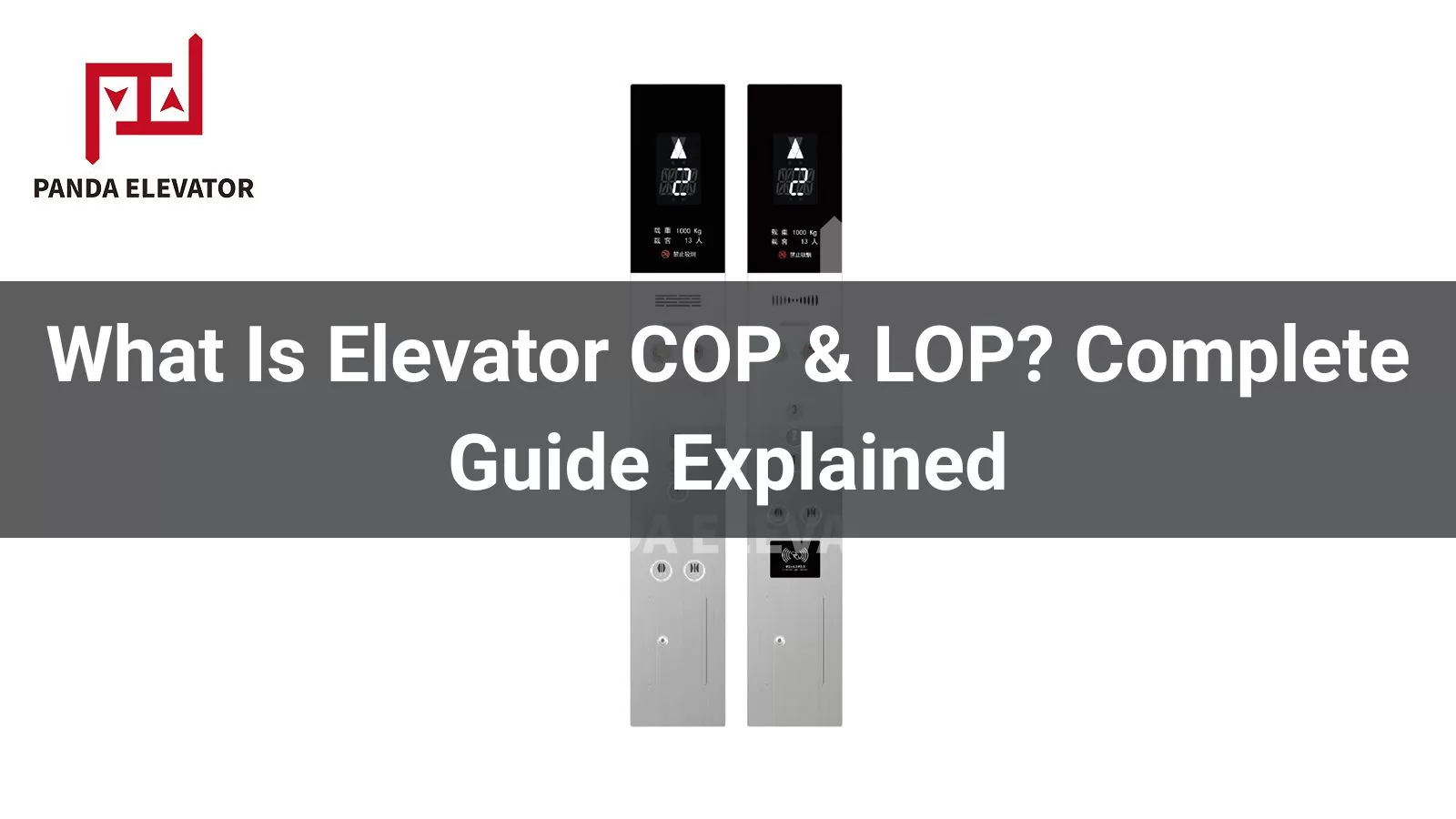

Elevator systems rely on a variety of control panels to ensure smooth, safe, and user-friendly operation. Among them, the Car Operating Panel (COP) plays a crucial role as the main interface inside the elevator cabin. It allows passengers to select floors, open and close doors, and use emergency controls when needed.
Whether you are an elevator technician, property manager, or procurement officer looking to understand these components better, this comprehensive guide will walk you through everything you need to know about elevator COP and LOP systems.
COP stands for Car Operating Panel, a control interface located inside the elevator car. It enables passengers to interact directly with the elevator system, select floors, and access various operational controls. The design and functionality of the COP vary depending on the elevator type, capacity, and manufacturer.
A typical elevator COP includes a combination of buttons, display screens, and indicators. It is designed for both efficiency and accessibility, ensuring passengers can operate the elevator safely and conveniently. Modern COPs often feature LED or LCD displays, tactile buttons, Braille markings, and voice annunciators to assist all users, including those with visual impairments.
Because the COP serves as the elevator’s “command center,” its design must ensure high durability, intuitive operation, and compliance with global safety standards. Manufacturers also customize COP layouts to match building aesthetics or branding requirements.
LOP stands for Landing Operating Panel, which is installed outside the elevator car, typically beside the doors on each floor. It serves as the external interface that allows users to call the elevator to their floor and indicate the direction they wish to travel (up or down).
Unlike the COP, which is located inside the cabin, the LOP helps manage elevator traffic from the outside. It usually features buttons, indicators, and sometimes voice or digital display systems to communicate the elevator’s status and arrival direction to waiting passengers.
Just like COPs, the design and quality of an LOP affect both user satisfaction and long-term reliability. In large buildings or premium installations, the aesthetics of the LOP often complement the building’s interior design, combining functionality with modern elegance.
| Feature | Elevator COP (Car Operating Panel) | Elevator LOP (Landing Operating Panel) |
|---|---|---|
| Installation Location | Inside the elevator cabin | Outside the elevator, near the doors on each floor |
| Main Purpose | Allows passengers to select floors and control doors | Used to call the elevator to a desired floor |
| Users | Passengers inside the elevator | People waiting for the elevator |
| Typical Controls | Floor buttons, door controls, alarm, emergency stop, display screen | Up/Down buttons, direction indicators, arrival lights, sometimes touchscreen |
| Accessibility Features | Braille, voice annunciation, illuminated indicators | LED display, visual indicators, sometimes sound alerts |
In short, both panels serve different purposes but complement each other to ensure a seamless elevator experience. The LOP manages elevator calls externally, while the COP manages all operations internally.
Although designs may vary, most COPs share several essential components that allow safe and efficient operation:
Modern elevator COP systems are designed not only for usability but also for aesthetics, accessibility, and safety. Below are the most common and advanced features found in contemporary elevator COPs:
By combining ergonomic design with advanced technology, modern COPs enhance user experience and ensure compliance with international elevator safety standards.
The material selection of elevator panels is one of the most important factors affecting their durability, appearance, and maintenance needs. Since these panels are used frequently and exposed to constant touch, they must be built from materials that combine strength, corrosion resistance, and visual appeal.
The right material not only enhances the longevity of the elevator panels but also reflects the overall quality and sophistication of the elevator system.
The cost of elevator COP and LOP panels varies widely based on their material, design complexity, and added features. Here’s a general pricing breakdown to help estimate the cost range:
| Panel Type | Average Price Range (USD) | Remarks |
|---|---|---|
| Standard COP | $140 – $200 | Includes floor buttons, indicators, and basic emergency controls. |
| Premium COP | $250 – $400+ | Features touch screens, LED display, voice function, and custom finishes. |
| Standard LOP | $20 – $60 | Basic up/down buttons and indicator lights. |
| Advanced LOP | $80 – $150 | Includes digital display, voice prompts, or destination entry system. |
Customization and advanced technology—such as card readers, touch displays, or multi-language support—can increase the price further. It’s also important to consider installation and maintenance costs, as these contribute to the overall investment in elevator modernization or new installation projects.
Selecting the right COP and LOP requires balancing technical performance, user experience, and long-term maintenance. Here are several factors to consider before making a decision:
By evaluating these factors, you can ensure that your elevator panels deliver excellent performance, safety, and aesthetics for years to come.
Panda Elevator is a trusted manufacturer and supplier of high-quality Elevator COP and LOP panels designed for both modernization projects and new installations. With advanced production technology and a focus on user safety and design aesthetics, Panda Elevator provides customized control solutions that enhance the overall elevator experience.
If you’re seeking durable, visually appealing, and user-friendly elevator control panels, contact Panda Elevator today to request a quote or learn more about our elevator COP and LOP solutions.
Proper maintenance of the Car Operating Panel (COP) is essential to ensure the safe and efficient operation of an elevator system. Because it is a high-usage component, frequent inspections and prompt servicing can prevent costly breakdowns and extend its lifespan.
Routine visual checks should be performed to detect signs of wear, stuck buttons, or flickering indicator lights. Maintenance personnel should also verify that all emergency buttons and signals are functioning correctly.
COP panels are typically made of stainless steel or tempered glass, requiring gentle cleaning with non-corrosive materials to maintain hygiene and appearance. Excess moisture or harsh cleaning agents can damage internal circuits, so controlled cleaning methods are recommended.
In smart elevator systems, COP software updates can enhance functionality, improve security, and fix bugs. Facility managers should coordinate with elevator service providers to ensure the latest updates are installed regularly.
To comply with accessibility standards, features such as Braille, audible indicators, and visual displays should be checked periodically to ensure they are operational and meet the needs of passengers with disabilities.
Choosing a suitable Car Operating Panel depends on various factors, including building type, design aesthetics, and system requirements. Below are some considerations for selecting the right COP:
PANDA Elevator offers a wide range of high-quality Car Operating Panels designed for modern, smart, and energy-efficient elevator systems. With years of industry experience, PANDA provides customizable COP solutions that meet global standards and enhance both functionality and aesthetics.
PANDA’s COPs are suitable for a wide variety of applications—from residential apartments to high-rise commercial buildings. Each product undergoes strict quality testing and conforms to ISO and EN81 standards, ensuring safe, smooth, and efficient operation.
The COP (Car Operating Panel) is installed inside the elevator cabin, while the LOP (Landing Operating Panel) is placed at each floor landing for calling the elevator. COP controls the movement from inside, whereas LOP requests the elevator from outside.
Yes. In many cases, older elevators can be retrofitted with modern COPs to improve user experience, safety, and aesthetics without replacing the entire system.
Modern touchscreen COPs are designed for durability and heavy usage, using industrial-grade materials and anti-vandal technology. However, regular cleaning and maintenance are essential to ensure performance.
Routine maintenance is typically performed every 3–6 months, depending on elevator traffic and manufacturer recommendations.
Yes, PANDA Elevator provides fully customizable COPs based on client requirements, including size, material, interface layout, and branding options.
The Car Operating Panel (COP) is the central interface between passengers and the elevator system, combining safety, functionality, and design aesthetics in one essential component. Whether you are upgrading an existing system or designing a new installation, selecting a high-quality COP ensures user satisfaction, reliability, and long-term performance.
PANDA Elevator stands out as a trusted manufacturer offering innovative and customizable COP solutions that meet the demands of modern buildings worldwide. For more details or to request a quote, contact PANDA today.



